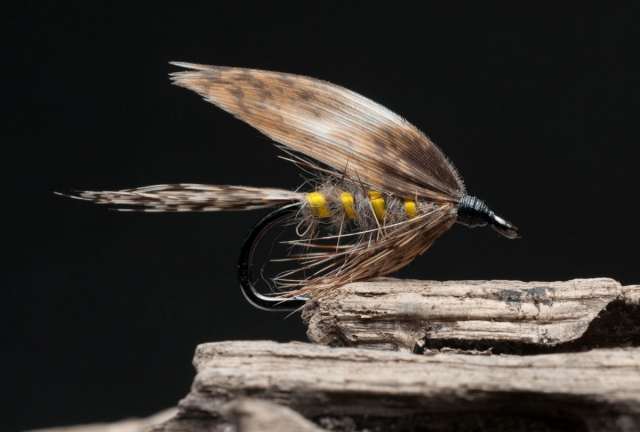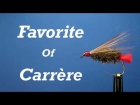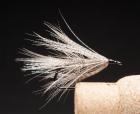The Mia Fly
Most dog owning fly fishers have probably combed their dogs and been struck by the fact that dogs' hair would make a fine dubbing material. Danish fly angler and photographer Mark Vagn Hansen did so with his dog Mia.
Dogs and flies are two things that go fine together

Get youself a dog and tie a Mia Fly
Pattern by Mark Vagn Hansen
Using dogs hair for flies is probably quite common. Most dog owning fly fishers have probably combed their dogs and been struck by the fact that dogs' hair would make a fine dubbing material. Photographer Mark Vagn Hansen did so with his dog Mia, and wound up tying a very productive pattern used for sea trout and - naturally - named it The Mia Fly.
Grub like
The fly uses the same basic structure as another of Mark's files, the Dalby Dribbler. The concept with two hackles is know from the grub and shrimp types of salmon flies, nad indeed works very well for sea trout too.
Hair sources

You can pick up dog hair in many places. This was found in a local park.
If you do not own a dog, then give your dog loving friends a bunch of small ziplock bags, and have them fill the bags each time they groom their canine friends. Notice that puppet hair is best and that you want all the hair - guard hairs and underfur. The long often soft guard hairs combine well with the finer and often lighter underfur. Use a coffee grinder to mix the different materials and be careful not to overload it with too much material at once. Using dogs hair will generally mean very little control with colors - unless you have access to the same dog or species of dogs for a long time.
Materials:
| Hook | Kamasan b175, #6 |
| Tag | Holographic tinsel |
| Rear hackle | Large fiery brown rooster |
| Rib | Copper wire |
| Body | Mix 1:1:1 - SLF Poul Jorgensen signature, Fiery Claret #21 - Polar Dub, claret - Chocolate brown hair from 15 years old Cocker Spaniel |
| Front hackle | Smaller firery brown rooster |

Holographic tag and dog hair body on the Mia Fly
Tying instructions
- Start tying thread behind eye and cover two thirds of the hook shank
- Tie in tinsel under the shank over the point of the hook and wind towards the rear of the hook
- Make a tag reaching the point over the tip of barb and return to tying in point
- Tie off the tinsel and cut surplus
- Prepare a fairly large hackle - approx. twice the hook gap - by removing plumulacous part
- Tie in a base first, shiny side forwards and wind 3-4 turns as a classical wet fly style
- Cut surplus
- Tie in copper wire under the hook shank
- Dub the thread and wind forwards in close turns to form a thick, flufy body
- Wind ribbing with 4-5 turns in opposite direction
- Tease out the body with velcro
- Prepare a second hackle
- Tie in a base first, shiny side forwards and wind 3-4 turns similar to rear hackle
- Tie of and cut surplus
- Form a small head
- Whip finish and varnish
Read more about why you should register.
More content from the front page
Since you got this far …
… I have a small favor to ask.
Long story short
Support the Global FlyFisher through several different channels, including PayPal.
Long story longer
The Global FlyFisher has been online since the mid-90's and has been free to access for everybody since day one – and will stay free for as long as I run it.
But that doesn't mean that it's free to run.
It costs money to drive a large site like this.
See more details about what you can do to help in this blog post.





























































Comments
If anyone without ac
If anyone without access to a dog needs dog hair - just go to a dog hairdresser. They will give you more then just a big bag full of it.